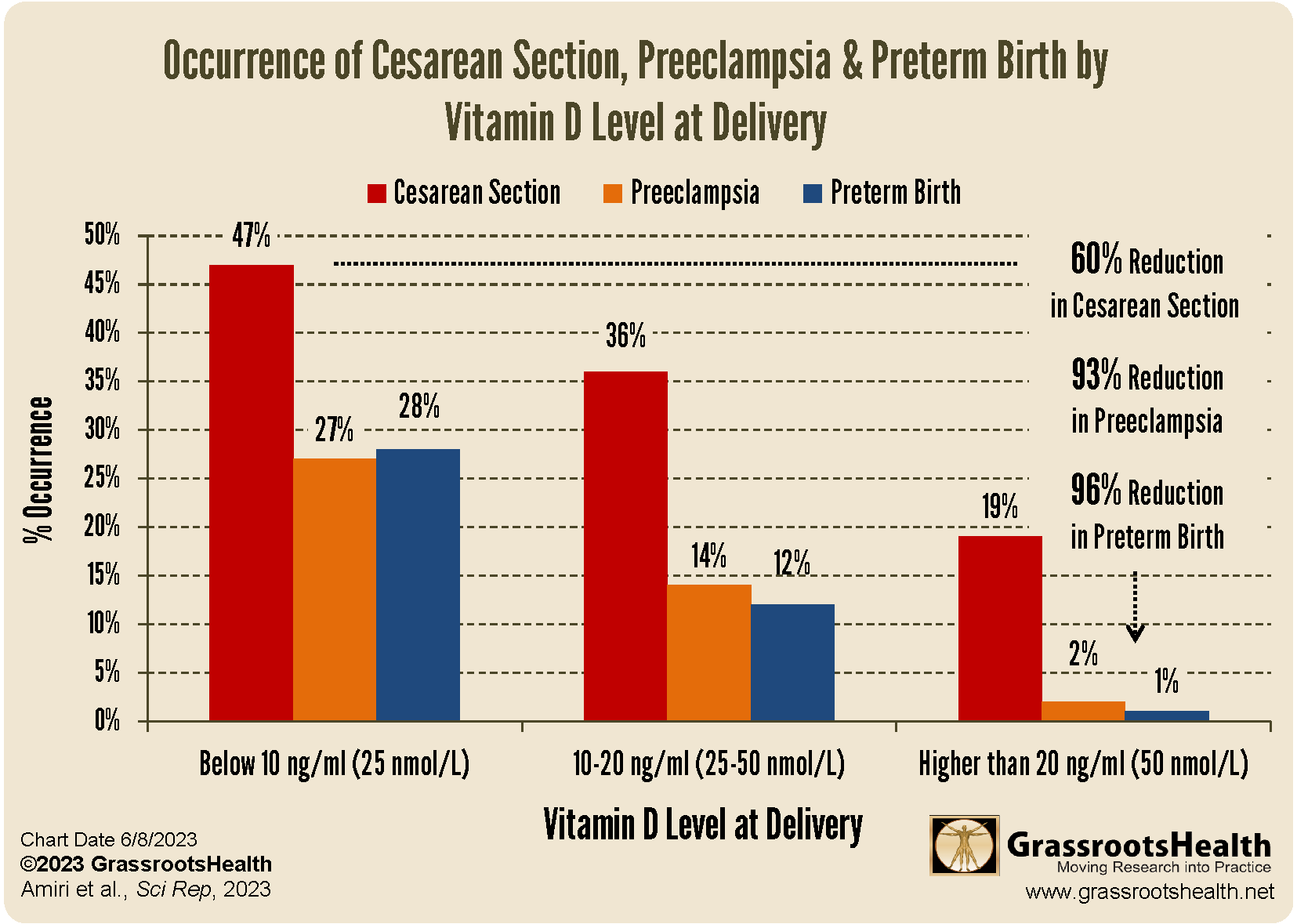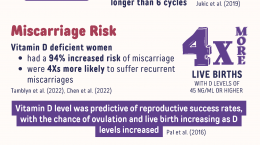Published on June 8, 2023
New study finds 60% reduction in cesarean section, 93% reduction in preeclampsia, and 96% reduction in preterm birth among women whose vitamin D level was higher than 20 ng/ml vs below 10 ng/ml at birth
Key Points
- Maintaining healthy vitamin D levels of at least 40 ng/ml or 100 nmol/L throughout pregnancy is essential to prenatal and newborn health
- A new study showed that women with moderate and severe vitamin D deficiency at the time of delivery had much higher rates of cesarean section, preeclampsia, and preterm delivery compared to women with higher vitamin D levels; the study also found significantly higher rates of pregnancy complications, such as gestational diabetes and low birth weight, among women who had not been receiving vitamin D during pregnancy
- Women whose vitamin D level was higher than 20 ng/ml at the time of delivery experienced a 60% reduction in cesarean section, 93% reduction in preeclampsia, and 96% reduction in preterm birth, compared to women whose vitamin D level was below 10 ng/ml
 Many studies have been published to demonstrate the effects of vitamin D levels during pregnancy on prenatal, birth, and newborn health outcomes, including a study by GrassrootsHealth showing a 62% lower risk of preterm birth for women whose vitamin D level reached at least 40 ng/ml (100 nmol/L) during pregnancy compared to women below 20 ng/ml (50 nmol/L).
Many studies have been published to demonstrate the effects of vitamin D levels during pregnancy on prenatal, birth, and newborn health outcomes, including a study by GrassrootsHealth showing a 62% lower risk of preterm birth for women whose vitamin D level reached at least 40 ng/ml (100 nmol/L) during pregnancy compared to women below 20 ng/ml (50 nmol/L).
A new study, reviewed below, further demonstrates the importance of avoiding low vitamin D levels during pregnancy.
Significant Effects of Vitamin D Level at Time of Delivery on Birth Outcomes
A study by Amiri et al. compared vitamin D levels at the time of delivery with the mode of delivery using a popular data mining algorithm called the Bayesian Network (BN) method. The data analyzed came from a randomized controlled trial of 1649 pregnant women which measured vitamin D levels among pregnant women and treated women presenting with moderate or severe vitamin D deficiency at baseline with differing vitamin D dosing regimens.
Results of the analysis showed that women with moderate [25(OH)D level of 10-20 ng/ml or 25-50 nmol/L] and severe [below 10 ng/ml or 25 nmol/L] vitamin D deficiency at the time of delivery had much higher rates of cesarean section, preeclampsia, and preterm delivery compared to women with vitamin D levels of higher than 20 ng/ml (50 nmol/L). As illustrated in the chart below, among women whose vitamin D level was below 10 ng/ml at the time of delivery, the percent occurrence of cesarean section was 47%, preeclampsia was 27%, and preterm birth 28%, compared to 19% occurrence of cesarean section, 2% preeclampsia, and 1% preterm birth for women whose vitamin D level was higher than 20 ng/ml.
In all, women whose vitamin D level was higher than 20 ng/ml at the time of delivery experienced a 60% reduction in cesarean section, 93% reduction in preeclampsia, and 96% reduction in preterm birth, compared to women whose vitamin D level was below 10 ng/ml.
The study also found significantly higher rates of pregnancy complications, such as gestational diabetes and low birth weight, among women who had not been receiving vitamin D treatment compared to women who had. While the women who had not been receiving vitamin D during pregnancy did present with a vitamin D level of 20 ng/ml or higher at baseline, it is important to note their resulting vitamin D levels at the time of delivery; severe vitamin D deficiency at the time of delivery was reported for only 2% of those receiving vitamin D, and 45% of those who were not receiving vitamin D treatment (but whose vitamin D level was at least 20 ng/ml at baseline).
This study highlights the extreme importance of supplementing with vitamin D to maintain sufficient vitamin D levels throughout pregnancy, for the health of both the mother and baby.
The authors concluded that
“the vitamin D status of pregnant women at delivery could directly affect the mode of delivery and indirectly through maternal complications, such as preeclampsia and preterm delivery, leading to a higher occurrence probability of cesarean section… screening all pregnant women for serum concentrations of 25(OH)D can help identify mothers at risk of adverse pregnancy outcomes.”
Learn more about how vitamin D affects reproductive, prenatal, and newborn health here.
Are You and Your Loved Ones Getting Enough Vitamin D and Other Important Nutrients?
The only way to know is to test your levels! Testing versus blind supplementation is essential to know for sure if what you are taking is the right amount for you. Once you test your vitamin D (and other levels) to know where you are NOW, you can account for any upcoming changes in lifestyle over the coming months and adjust your intake to reach (or maintain) your targets.
- Vitamin D
- Magnesium PLUS Elements
- Omega-3 Fatty Acids
- hsCRP
- HbA1c
- TSH
- Type 1 Diabetes Autoantibodies
Did you know that each of the above can be measured at home using a simple blood spot test? As part of our ongoing research project, you can order your home blood spot test kit to get your levels, followed by education and steps to take to help you reach your optimal target levels. Start by enrolling and ordering your kit to measure each of the above important markers, and make sure you are getting enough of each to support better mood and wellbeing!
Create your custom home test kit today. Take steps to improve the status of each of these measurements to benefit your overall health. With measurement you can then determine how much is needed and steps to achieve your goals. You can also track your own intakes, symptoms and results to see what works best for YOU.
Enroll in D*action and Test Your Levels Today!







